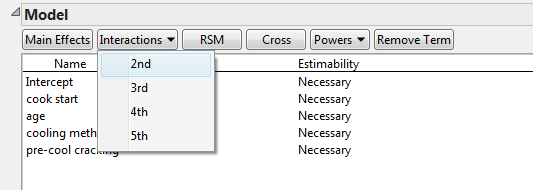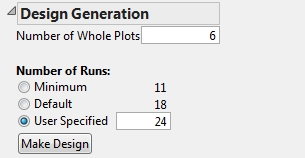- JMP User Community
- :
- JMP Technical Resources
- :
- Technical Details
- :
- R&D Blog
- :
- An eggciting designed eggsperiment
- Subscribe to RSS Feed
- Mark as New
- Mark as Read
- Bookmark
- Subscribe
- Printer Friendly Page
- Report Inappropriate Content

A typical scene in my kitchen: I make a batch of hard-boiled eggs with the hope of an easy peel and a beautifully cooked center. But when I sit down to enjoy my egg, I find that, sadly, it’s not so easy to peel – or I have discoloration around the yolk (or worse yet, sometimes both occur).
Here's how I've been preparing my hard-boiled eggs: I start with the eggs in a pot of cold water. Then, I bring the pot to a boil, remove it from the heat and cover the pot for 12 minutes. After a recent disappointing experience with both overcooked and hard-to-peel eggs, I decided to investigate further in a quest to make better hard-boiled eggs.
My Internet search revealed that almost everyone claims to have a foolproof way to make hard-boiled eggs, but a quick browse through comments shows mixed results. Some common themes and questions appear, so it sounded like the perfect opportunity to use a designed experiment to separate fact from folklore.
For a first try at this eggsperiment, my budget for runs was two dozen eggs – same size/brand, purchased two weeks apart. Perhaps in a future experiment, I will use more eggs, but I wanted the peeler (my wife) to be blinded from knowing how the egg was prepared. Since I wasn’t going to be doing the peeling, 24 eggs seemed to be the limit of asking for help from my wife. I also quailed at the thought of having to eat so many egg salad sandwiches in a short period of time.
While most cooking methods for hard-boiled eggs start with cold water, a recent blog post had me intrigued about putting the eggs directly into boiling water.
So I ultimately decided on the following factors to study:
- Cooking method (start with cold water or put into boiling)
- Age of the egg (purchased two weeks ago or newly purchased)
- Cooling method (ice bath or cold tap water)
- Pre-cool crack (yes or no)
The pre-cool crack indicates whether I cracked the egg before using the cooling method in 3. If you’re familiar with design of experiments, you may recognize that not all of these factors are equally easy to change. For factors 2-4, I can assign these on an egg-by-egg basis (that is, they’re easy to change). For the cooking method, it is much more convenient if I cook more than one egg at a time. Thus, cooking method is a hard-to-change variable, or whole plot variable in the parlance of split-plot designs.
This means that the estimate of the effect of the cooking method is based on the number of batches I cook rather than the number of eggs. I ultimately decided on six batches of four eggs, or six whole plots. While this gives me only three batches for each cooking method, I hoped that I would get at least some indication whether changing the cooking method mattered. For the easy-to-change factors, I’m more likely to detect the important effects because of the number of eggs I have.
For the cooking method, I cooked one batch at a time in the same pot. I used the same amount of water in each batch (2 cups). The start with cold water was heated on medium until the water reached 188 degrees Fahrenheit, at which point I turned off the heat and covered the pot for 10 minutes. For the boiling method, I waited until the water just started boiling and put the eggs in for 11 minutes, while reducing the temperature to medium so that the water was simmering.
The Responses
My main purpose here was to find out about ease of peeling, but there is still the aspect of whether or not a peeled egg is aesthetically pleasing. The final responses measured were:
- Peel time (in seconds)
- Attractiveness of the egg (rating from 1 to 5)
- Ease of peel (rating from 1 to 5)
While 1 and 3 seem similar, the peel time is likely to be very noisy and may not always pick up on frustration that can arise while peeling, which ease of peel should capture.

The Experiment
Now it’s time to design the experiment. The first step is to enter my responses and factors in the Custom Design platform, which is the first item under the DOE menu. We get something that looks like this:
Notice that all of the factors are set to “Easy” under the Changes column in the Factors table. To change cook start to be hard-to-change, click on the “Easy” under the Changes column for the cook start factor and select “Hard” from the list that comes up.
If we click the Continue button at the bottom, it’s time to set up the rest of the design. By default, the model is set to be able to estimate the main effects. With 24 eggs, we should be able to look at two-factor interactions, so I select Interactions -> 2nd to have the Custom Designer ensure the design can estimate all the main effects and two-factor interactions.
Finally, we need to set up the appropriate run size. Recall that we want six batches of four eggs (24 eggs total). Under the Design Generation tab, this means we set the Number of Whole Plots to 6, and the Number of Runs to 24.
Clicking the Make Design button, and the experiment is ready to go. The design will look something like this:
Any predictions as to the results? I’ll reveal the results next week.
You must be a registered user to add a comment. If you've already registered, sign in. Otherwise, register and sign in.
- © 2024 JMP Statistical Discovery LLC. All Rights Reserved.
- Terms of Use
- Privacy Statement
- About JMP
- JMP Software
- JMP User Community
- Contact





